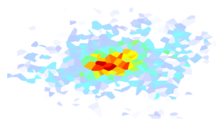shakelib.correlation.loth_baker_2013¶
-
class
shakelib.correlation.loth_baker_2013.LothBaker2013(periods)[source]¶ Bases:
shakelib.correlation.ccf_base.CrossCorrelationBaseCreated by Christophe Loth, 12/18/2012 Pythonized and vectorized by C. Bruce Worden, 3/15/2017 Updated with the erratum tables by C. Bruce Worden, 1/13/2021 Compute the spatial correlation of epsilons for the NGA ground motion models
The function is strictly empirical, fitted over the range the range 0.01s <= t1, t2 <= 10s
Documentation is provided in the following paper: Loth, C., and Baker, J. W. (2013). “A spatial cross-correlation model of ground motion spectral accelerations at multiple periods.” Earthquake Engineering & Structural Dynamics, 42, 397-417.
Updated to include the erratum of: Loth, C., and Baker, J. W. (2019). “Erratum: A spatial cross-correlation model for ground motion spectral accelerations at multiple periods.” Earthquake Engineering & Structural Dynamics, 49(3), 315-316. https://doi.org/10.1002/eqe.3233
Create an instance of LB13.
- Parameters:
periods (numpy.array) – An array of periods that will be requested from the function. Values must be [0.01 -> 10.0], and must be sorted from smallest to largest.
- Returns:
An instance of
LothBaker2013.
-
getCorrelation(ix1, ix2, h)[source]¶ Compute the correlation between two periods and a separation distance of h.
The indices (ix1 and ix2) and h must have the same dimensions. The indices may be equal, and there is no restriction on which one is larger. The indices refer to periods in the ‘period’ argument to the class constructor. The result is stored in h.
- Parameters:
ix1 (2D, C-contiguous numpy array)) – The indices of the first period of interest.
ix2 (2D, C-contiguous numpy array)) – The indices of the second period of interest.
h (2D, C-contiguous numpy array)) – The separation distance between two sites (units of km). h will be returned with the result, so it must be copied if the values in h are to be preserved.
- Returns:
The predicted correlation coefficient. The output array will have the same shape as the inputs.
- Return type:
h (numpy array)
